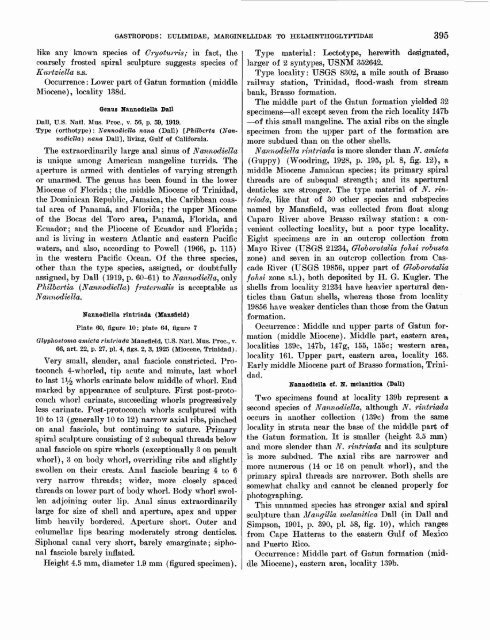Geology and Paleontology of Canal Zone and Adjoining ... - USGS
Geology and Paleontology of Canal Zone and Adjoining ... - USGS
Geology and Paleontology of Canal Zone and Adjoining ... - USGS
Create successful ePaper yourself
Turn your PDF publications into a flip-book with our unique Google optimized e-Paper software.
GASTROPODS: EULIMIDAE, MARGINELLIDAE TO HELMINTHOGLYPTIDAE 395<br />
like any known species <strong>of</strong> Cryoturris; in fact, the<br />
coarsely frosted spiral sculpture suggests species <strong>of</strong><br />
Kurtziella s.s.<br />
Occurrence: Lower part <strong>of</strong> Gatun formation (middle<br />
Miocene), locality 138d.<br />
Genus Nannodiella Ball<br />
Dall, U.S. Natl. Mus. Proc., v. 56, p. 59, 1919.<br />
Type (orthotype): Nannodiella nana (Dall) [Philberta (Nan-<br />
nodiella) nana Dall], living, Gulf <strong>of</strong> California.<br />
The extraordinarily large anal sinus <strong>of</strong> Nannodiella<br />
is unique among American mangeline turrids. The<br />
aperture is armed with denticles <strong>of</strong> varying strength<br />
or unarmed. The genus has been found in the lower<br />
Miocene <strong>of</strong> Florida; the middle Miocene <strong>of</strong> Trinidad,<br />
the Dominican Republic, Jamaica, the Caribbean coas<br />
tal area <strong>of</strong> Panama, <strong>and</strong> Florida; the upper Miocene<br />
<strong>of</strong> the Bocas del Toro area, Panama, Florida, <strong>and</strong><br />
Ecuador; <strong>and</strong> the Pliocene <strong>of</strong> Ecuador <strong>and</strong> Florida;<br />
<strong>and</strong> is living in western Atlantic <strong>and</strong> eastern Pacific<br />
waters, <strong>and</strong> also, according to Powell (1966, p. 115)<br />
in the western Pacific Ocean. Of the three species,<br />
other than the type species, assigned, or doubtfully<br />
assigned, by Dall (1919, p. 60-61) to Nannodiella, only<br />
Philbertia (N annodiell'O) fratertmlis is acceptable as<br />
Nannodiella.<br />
Nannodiella rintriada (Mansfield)<br />
Plate 60, figure 10; plate 64, figure 7<br />
Glyphostoma amicta rintriada Mansfield, U.S. Natl. Mus. Proc., v.<br />
66, art. 22, p. 27, pi. 4, figs. 2, 3, 1925 (Miocene, Trinidad).<br />
Very small, slender, anal fascicle constricted. Pro-<br />
toconch 4-whorled, tip acute <strong>and</strong> minute, last whorl<br />
to last 11/2 whorls carinate below middle <strong>of</strong> whorl. End<br />
marked by appearance <strong>of</strong> sculpture. First post-proto-<br />
conch whorl carinate, succeeding whorls progressively<br />
less carinate. Post-protoconch whorls sculptured with<br />
10 to 13 (generally 10 to 12) narrow axial ribs, pinched<br />
on anal fascicle, but continuing to suture. Primary<br />
spiral sculpture consisting <strong>of</strong> 2 subequal threads below<br />
anal fascicle on spire whorls (exceptionally 3 on penult<br />
whorl), 3 on body whorl, overriding ribs <strong>and</strong> slightly<br />
swollen on their crests. Anal fascicle bearing 4 to 6<br />
very narrow threads; wider, more closely spaced<br />
threads on lower part <strong>of</strong> body whorl. Body whorl swol<br />
len adjoining outer lip. Anal sinus extraordinarily<br />
large for size <strong>of</strong> shell <strong>and</strong> aperture, apex <strong>and</strong> upper<br />
limb heavily bordered. Aperture short. Outer <strong>and</strong><br />
columellar lips bearing moderately strong denticles.<br />
Siphonal canal very short, barely emarginate; sipho-<br />
nal fascicle barely inflated.<br />
Height 4.5 mm, diameter 1.9 mm (figured specimen).<br />
Type material: Lectotype, herewith designated,<br />
larger <strong>of</strong> 2 syntypes, USNM 352642.<br />
Type locality: <strong>USGS</strong> 8302, a mile south <strong>of</strong> Brasso<br />
railway station, Trinidad, flood-wash from stream<br />
bank, Brasso formation.<br />
The middle part <strong>of</strong> the Gatun formation yielded 32<br />
specimens all except seven from the rich locality 147b<br />
<strong>of</strong> this small mangeline. The axial ribs on the single<br />
specimen from the upper part <strong>of</strong> the formation are<br />
more subdued than on the other shells.<br />
Nannodiella rintriada is more slender than N. amicta<br />
(Guppy) (Woodring, 1928, p. 195, pi. 8, fig. 12), a<br />
middle Miocene Jamaican species; its primary spiral<br />
threads are <strong>of</strong> subequal strength; <strong>and</strong> its apertural<br />
denticles are stronger. The type material <strong>of</strong> N. rin<br />
triada, like that <strong>of</strong> 30 other species <strong>and</strong> subspecies<br />
named by Mansfield, was collected from float along<br />
Caparo Eiver above Brasso railway station: a con<br />
venient collecting locality, but a poor type locality.<br />
Eight specimens are in an outcrop collection from<br />
Mayo River (<strong>USGS</strong> 21234, Globorotalia fohsi robusta<br />
zone) <strong>and</strong> seven in an outcrop collection from Cas<br />
cade River (<strong>USGS</strong> 19856, upper part <strong>of</strong> Globorotalia<br />
fohsi zone s.l.), both deposited by H. G. Kugler. The<br />
shells from locality 21234 have heavier apertural den<br />
ticles than Gatun shells, whereas those from locality<br />
19856 have weaker denticles than those from the Gatun<br />
formation.<br />
Occurrence: Middle <strong>and</strong> upper parts <strong>of</strong> Gatun for<br />
mation (middle Miocene). Middle part, eastern area,<br />
localities 139c, 147b, 147g, 155, 155c; western area,<br />
locality 161. Upper part, eastern area, locality 163.<br />
Early middle Miocene part <strong>of</strong> Brasso formation, Trini<br />
dad.<br />
Nannodiella cf. N. melanitica (Dall)<br />
Two specimens found at locality 139b represent a<br />
second species <strong>of</strong> Nannodiella, although N. rintriada<br />
occurs in another collection (139c) from the same<br />
locality in strata near the base <strong>of</strong> the middle part <strong>of</strong><br />
the Gatun formation. It is smaller (height 3.5 mm)<br />
<strong>and</strong> more slender than N. rintriada <strong>and</strong> its sculpture<br />
is more subdued. The axial ribs are narrower <strong>and</strong><br />
more numerous (14 or 16 on penult whorl), <strong>and</strong> the<br />
primary spiral threads are narrower. Both shells are<br />
somewhat chalky <strong>and</strong> cannot be cleaned properly for<br />
photographing.<br />
This unnamed species has stronger axial <strong>and</strong> spiral<br />
sculpture than Mangilia melanitica Dall (in Dall <strong>and</strong><br />
Simpson, 1901, p. 390, pi. 58, fig. 10), which ranges<br />
from Cape Hatteras to the eastern Gulf <strong>of</strong> Mexico<br />
<strong>and</strong> Puerto Rico.<br />
Occurrence: Middle part <strong>of</strong> Gatun formation (mid<br />
dle Miocene), eastern area, locality 139b.

















